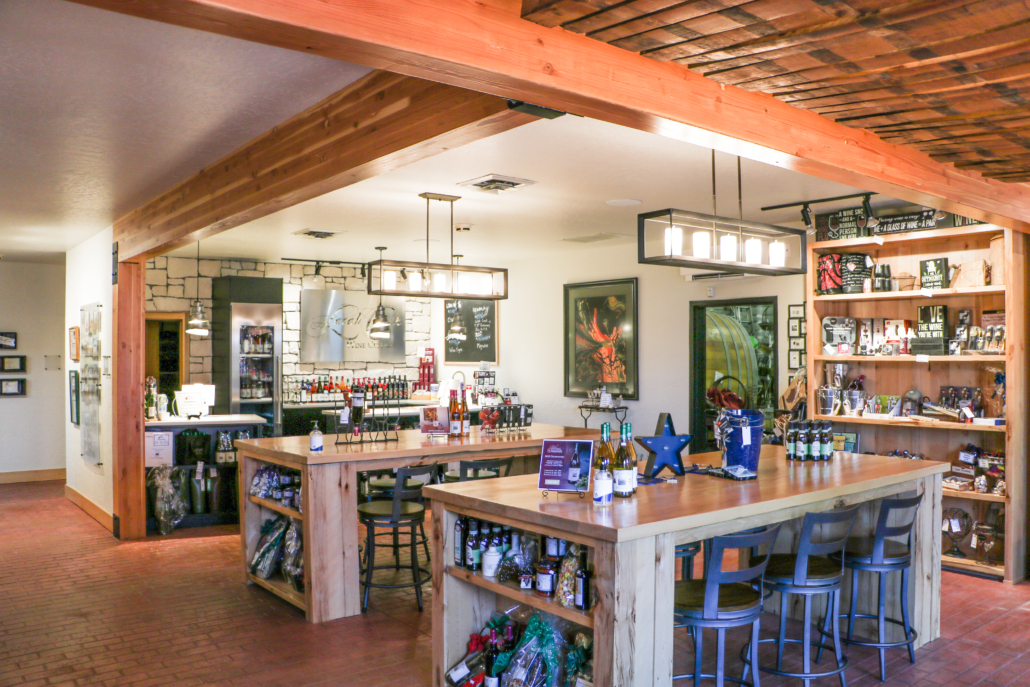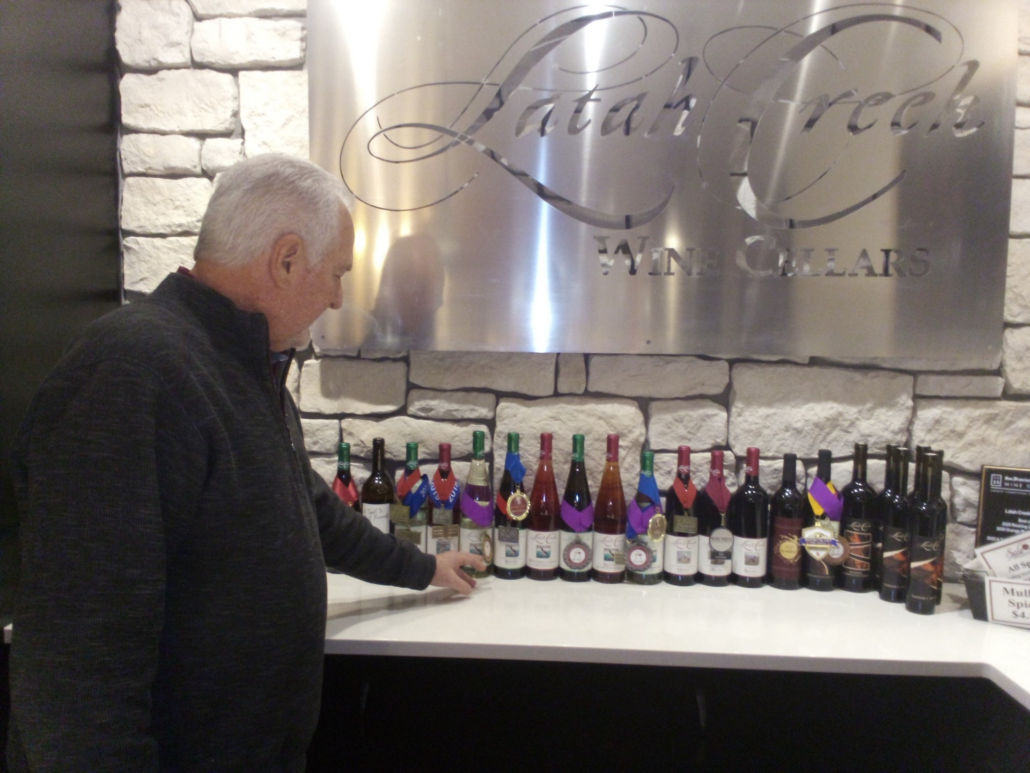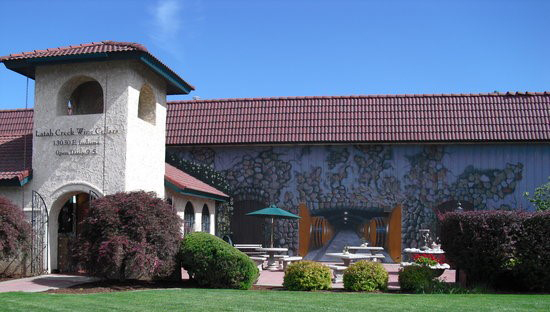Latah Creek Wine Cellars: Spokane Winery Still Making
Award-Winning Wine After All These Years.
For Mike and Ellena Conway and their daughter Natalie, making wine has been a family affair since Natalie took over the duties as winemaker in 2004.
By Sebastian Moraga

For Natalie Conway-Barnes (center), who took over the duties as winemaker at Latah Creek Wine Cellars in 2004, working for her dad, Mike, and mom, Ellena all these years has worked out just fine.
It’s not easy to intertwine business with family, but for Mike Conway and his daughter Natalie Conway-Barnes, it works just fine.
Mike and his wife Ellena founded Latah Creek Wine Cellars in Spokane back in 1982, and some years later, they welcomed daughter Natalie into the fold. A vintner’s kid who grew up around barrels and long-stemmed glasses, Natalie became the winemaker for her father in 2004.
Mike, a California resident for years, had moved to Spokane in 1980 to work as the first winemaker for what was then Worden’s Washington Winery. Two years later, he had his own shop.
In the meantime, what would eventually become a booming industry in Washington had already begun to make noise, with more than 20 wineries opening between 1981 and 1982, including Latah Creek, the 35th one.
A few years later, there would be more than 200. Latah Creek is one of the few that is still around from those early days.
A microbiology expert whose career stops had included fabled names like Franzia and Gallo before the move up north, Mike credits Northern California wine giant John Parducci as his mentor.
“That’s where I actually learned to make wine,” he says of Parducci’s shop in Mendocino County. “I did not even know Washington had a wine industry,” he later added.
The anything-goes feel of the then-nascent Washington wine industry was invigorating for Mike. “It was fun,” he said. “Everybody in the business knew everybody else. If you needed help you just called somebody.”
After a couple of years with Worden’s, he fell in love with the area and the potential of the market and decided to open his own shop. He tugs no heartstrings, least of all his own, when thinking back to his first vintage.
“It was business at that time,” he said. “It was never a given passion that I was going to be a winemaker. It just happened, and that happened to be our first vintage. Looking back, you think, ‘Gosh, what an exciting moment,’ but at the time it was just business. I knew what had to be done to make money.”
The choice of the name Latah Creek for his winery was the result of an anonymous note left in Mike’s mailbox that consisted of a list of names for his future business. One name on the list caught Mike’s eye, although he didn’t know at the time what Latah Creek was.
“We all called it Hangman’s Creek,” Mike said. “We didn’t even realize there was a local significance when we initially saw the name. Naming it Hangman’s Creek was never an option.”
The name stuck and Latah Creek has been the Conways’ sole source of income since the day it opened in 1982 with an annual production of 1,600 cases.

The fourth volume of Ellena Conway’s recipe book titled “Recipes by Ellena ” contains 340 recipes that will make your mouth water, including such favorites as Cracked Pepper Steak, Red Wine Tri-Tip and Tequila Glazed Chicken. The book sells for $9.01 and can be purchased at the winery or online by visiting: latahcreek.orderport.net/wines/Ellenas-Cookbook.
Four decades later, their yearly output has grown to 12,000 cases, an amount they reached by design within two or three years. Two decades after reaching that mark, Natalie came along, and her path to a career in winemaking started, albeit a bit more circuitously.
Despite growing up around the bottles of wine her father made, Natalie aimed toward a career in physical therapy. And it wasn’t until after graduating college and getting married that she found that her future had been staring at her all along, inside of one of those bottles with the Yakima-area artist Floyd Broadbent’s birds on the label.
She had majored in biology, and when it came time to decide whether to enroll in a two-year master’s program in physical therapy, she instead chose to join the family business for the harvest of 2004.
“I love winemaking,” Natalie says. “Each variety has physical characteristics in it, like Pinot Gris has some of that lime, and Chardonnay will have tropical flavors, and Riesling, apple. There’s all the nuances in the way Mother Nature works. All of them are different.”
It was a Riesling harvest that served as a training ground for Natalie, Mike remembers. “The first harvest that she decided to work here with me, on a trial basis, we took two tanks of Riesling juice from grapes harvested from Quincy area-based Cave B winery, and I said ‘OK, I’m going to use the yeast that I’ve been using since the beginning of time on one tank, and for you, here’s the book. Choose what you want.”
From the start, Mike says his daughter had the drive to make wine making her passion. “She tried the wines every single day during the fermentation process, she saw what the end result was, and she said, ‘You know, I really like this. This is fun.’”
Looking back, Mike marvels at the similarities in the process of building a winemaker from the ground up.
“I taught her to make wine the way I was taught to make wine,” Mike says. Not being in a vineyard, and instead being on the brick and mortar-heavy east end of the Spokane Valley, Mike acquired all kinds of fruit in small amounts so Natalie could learn the ABCs of Nebbiolo and Barbera and Petit Verdot and Tempranillo and many others.
Nowadays, Natalie does most of the blending, and still loves to tinker with the different kinds of fruit. “I love being able to blend, and not in a cookie-cutter way,” she says. “But instead, whatever tastes best and allows each varietal’s flavors to come out is what I go with.”
Once the quarterback, Mike Conway is now more settled into a head-coach role, with his daughter under center.
“She’s the one who’s got the energy to do things,” Mike says. “Plus, she’s got so much more on her plate than I ever had, with all the social-media stuff now and everything that’s involved with marketing, it’s so much different and more time consuming than it was when we started. We used to just place an ad in a newspaper and that was it.”
One thing that does not change is the zip code. Always near the Lilac City, and with no plans or desire to move. “Spokane has always been home,” he says. “The only thing we don’t have here is grapes,” and those are but a short drive away. Sixty to 70 percent of the fruit comes from the Quincy Valley, some comes from the Wahluke Slope, and the Pinot Gris grapes come from the Yakima Valley.
Married to Ellena for 54 years, Mike says working with your spouse and daughter can be tricky sometimes. Natalie says working for dad has become working with dad over time, and it’s still fun.
“It’s great to be here with both my parents, and seeing them both all day long and taste wine and really make a decision as a group,” she says.

What sets Latah Creek Wine Cellars apart from most wineries in the state of Washington is its huge gift shop run by Ellena Conway that features wine accessories, gourmet foods, gift baskets. greeting cards, and Latah Creek wine, of course.
Ellena helps run the tasting room and order all the goodies they sell in the winery’s gift shop. She also put together a pretty impressive cookbook, filled with family recipes titled ‘Recipes by Ellena,’ “It’s fabulous for our customers,” Ellena says. “It’s 50 years’ worth of tried and true recipes.”
At the end of the day, when it comes time to wind down, there’s always a sip or two of the good stuff waiting for Mike and Ellena at home.
For Mike, it’s whiskey. Yes, whiskey. “Or Scotch,” Mike says. “I’m not a beer drinker, unless it’s a Guinness.” Ellena has wine with dinner every night, while Mike says he has wine with dinner half the time. And hardly ever does the bottle he opens say “Latah Creek” on the label. It’s wines from all over the world, but not from the shop on Indiana Avenue.
“It’s got nothing to do with lack of faith in the product,” Mike explained. “But if we are testing Sangioveses, that’s the only way we can really gauge how we want to finish off a Sangiovese, by tasting a good Sangiovese.”
For Natalie, it’s good wine waiting at home, but rarely the one she has spent the entire day tinkering with.
After years and years of topping out at about 12,000 cases, Mike says he gets asked quite often whether there are plans to grow. In a word: No. He wants to stay affordable.
“If we double our size, we can’t do it here, and even if we grow by 15 percent we can’t do it here. It requires more employees, different equipment.” Mike wants to enjoy life, and not become tied and enslaved to a gargantuan enterprise.
The same philosophy applies to their wine club, started “as an afterthought” with 100 members, and now holding steady at 280. “We’ve never really done a lot to grow it too much,” Mike said.

Over the years, Latah Creek Wine Cellars has won dozens of medals for its wine at various wine competitions. Mike Conway displays the medals on a table in his tasting room so visitors can see them up close. Photo by Sebastian Moraga.
The camaraderie among winemakers has survived the passage of time, even as the industry has grown and become more competitive. COVID hurt the supply chain, but not the strength of the customer base. Sit-down tastings stopped cold, of course, and finding corks, labels and bottles became scarcer and it’s just now starting to settle down.
The years post-COVID have presented Latah Creek with a different challenge: How to make do without all those COVID-era grants no longer available, but with costs still higher than the pre-COVID days. Freight alone doubled in cost last year.
“It’s still a little bit of a struggle, but we are seeing the light,” he said. Natalie agrees, saying “We have a very loyal fan base.”
“I’m not sure what’s going to happen next year or the year after or the year after, because there are not going to be homes for all the grapes out there,” Mike says.
Nevertheless, Mike is betting on his shop. Forty-two years since that two-page list got left in the mailbox, Mike says there’s only one reason why that name has lasted through three popes and seven presidents.
“The consistency and the quality of the wine,” he says. “It does not take long to lose customers when you make bad wine.” It also helps that they have made it a priority to keep their prices affordable.
“If you look at our wine lineup, we are considerably less expensive on a general scale across what we make than other wineries in the area,” he said. “We want everybody to enjoy a good bottle of wine for a reasonable price.”
The Latah Creek wine list includes reds such as a 2021 Cabernet Sauvignon, a 2018 Malbec, a 2019 Merlot, a 2019 Barbera, a blend named Mike’s Reserve (48 percent Cabernet Sauvignon, 22 percent Tempranillo, 17 percent Petit Verdot and 13 percent Syrah), and also a Sangria born out of Natalie’s incessant curiosity and desire to tinker.
“We sold like 100 cases in two weeks,” she says. “I love to experiment and keep things fresh and fun.”
There’s also a 2021 Natalie’s Nectar (their homage to the Recioto wine from northern Italy). Natalie’s Nectar continues to be a source of profound pride because it carries Natalie’s name and it was the first wine Latah Creek produced under her label.
Latah Creek’s white wines include a 2019 Chardonnay, a Chardonnay-Pinot Gris blend named “A Toast to Best Friends, (inspired by Ellena and her late best bud Janna) a 2022 Pinot Gris, a 2021 Rosé of Malbec, a 2022 Chenin Blanc, and a 2022 Riesling.
“Best Riesling in the state,” Mike says. “If you go back and look at all the wineries that make Riesling, I bet we have more awards than everybody else.”
A sweet Riesling, a 2022 Maywine, a 2022 Orange Moscato, (“the only true Moscato made in the state,” Mike proclaims,) and a 2022 huckleberry wine named “Huckleberry d’Latah,” close out the list of whites.
“That’s our biggest seller, the one that pays the bills,” says Mike of the Huckleberry wine, attributing part of its success to what he described as the longtime love affair of the Northwest with all things huckleberry.
And yet, when asked to save one bottle and only one from the proverbial flames of a hypothetical fire, Mike chooses his 2014 Petit Verdot. “That was one of our very first reserve wines,” he remembers.
Four decades on, and with his wine selling in four states, Mike says it’s still a kick to come in every day to work at the business he started from the ground up. He still shows up to work before everyone else in the morning.
“I can’t imagine what I would do if I did not have this,” he says. “Keeps me young, Keeps me active going up and down ladders and lifting cases. If I just sat home, I would probably wither away. I can’t get in and out of tanks like I used to, though.”
Natalie says she’s not looking forward to when Mom and Dad retire. For that matter, neither is Dad, it seems. He still treasures the grind, the effort and the reward of producing good wine at a good price.
“There’s nothing that goes out this door that I’m not proud of,” Mike concluded.
For those interested in experiencing Latah Creek wines firsthand, visitors are encouraged to stop by the tasting room, which is located at 13030 E. Indiana Ave., Spokane, WA. 99261. Phone: (509) 926-0164. The tasting room is open daily from 9 a.m. to 5 p.m.
If you live too far from Latah Creek to visit, you can buy all of the their current releases by visiting the winery’s on-line wine store at: latahcreek.orderport.net/wines/.
The best way to experience Latah Creek’s wines is to join the winery’s wine club. Wine club members free tastings at the Spokane tasting room, as well as a 20% discount on the purchase of 12 bottles or more and a 5% discount on the purchase of one to 11 bottles. Club levels are tailored to best suit members’ needs.
For more information about joining Latah Creek’s wine club, visit: latahcreek.orderport.net/wine-club.


